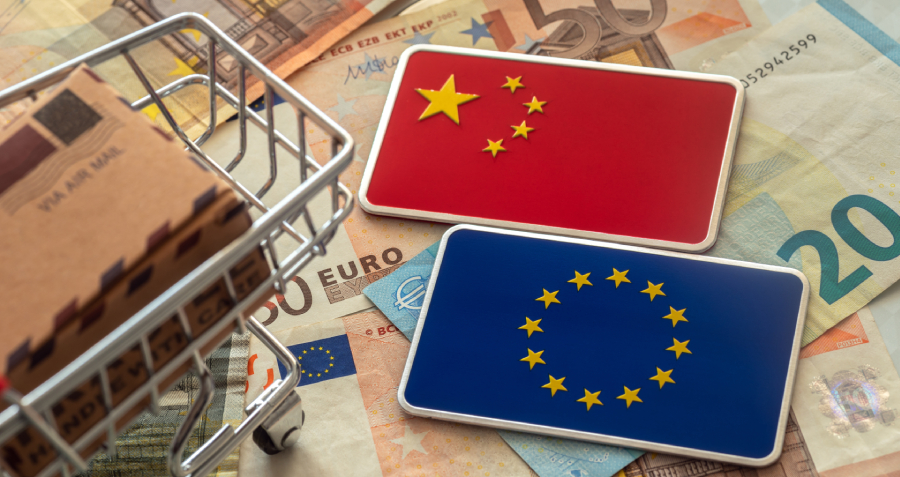In the midst of a moribund economy, China’s consumer confidence index (CCI) has been languishing at all-time low levels for the past three years. Despite reaching surprising highs during the first two years of the Covid-19 pandemic, the index has yet to recover from a 40-point drop at the beginning of 2022.
China’s cautious consumers are saving more than ever and appear unwilling to spend as they once did. And while the country’s leadership have acknowledged the need to fix the issue, a continued focus on supply-side stimulus rather than on boosting demand has meant tattempts have not yet borne fruit.
“Almost every leading developed economy has the consumer as the major driving force of the economy, and China will likely be no exception as it aims to transition its economy into the next phase,” says Lynn Song, Chief Economist, Greater China at ING. “So far, however, this is a work in progress.”
Spend or save?
Despite the Chinese government reporting a better than expected 5.4% GDP growth and 4.6% overall sales growth in Q1 of 2025, China’s CCI has been hovering around the 86 mark for the past three years, according to the National Bureau of Statistics, a steep downgrade from the highs of almost 200 in 2021. In terms of spending, household spending per capita in 2024 was $4,802, according to CEIC data, and has been steadily rising over the last decade, but remains low when compared to other Asian consumer-driven economies—in 2024, per capita household spending in Japan was $8,258 and South Korea had a per capita spending of $15,353.
Household savings deposits have also been rising consistently, and in 2024 sat at a total of ¥152 trillion ($21 trillion) up from ¥82 trillion in 2019, evidencing a more conservative approach to family finances.
Some consumer areas are still seeing growth, for example, overall retail sales and air travel grew 3.8% and 17.9% year-on-year in 2024, respectively. But the initial impact of the pandemic, among other issues, and a lack of a subsequent recovery has meant these numbers are subdued compared to five or six years ago.
“At the beginning of the pandemic, services spending in particular dropped due to lockdowns,” says Michelle Lam, Greater China Economist at Societe Generale SA. “After the economy re-opened in 2023, people were hoping to see some level of normalization, but they have been largely disappointed so far. Last year’s retail sales growth was less than half of the growth pre-covid.”
Underlying causes
Beyond the economic shock of the pandemic, there are several factors that impact China’s consumer spending, including the uncertainty around the current tit-for-tat trade tariffs between the US and China. Another of which is the country’s negative demographic trends.
“China’s population is expected to decline by 100 million in the next 30 years and the average age of the population is rising,” says Zhaopeng Xing, senior China strategist at ANZ. “It is currently around 40 years old, and the maximum consumption point by age usually peaks around 45, after which spending drops.”
Chinese citizens have also historically had a consistently high savings rate compared to international counterparts, with households siphoning away around a third of income. The uncertainty caused by pandemic restrictions, and the country’s lack of social welfare schemes have only served to increase those saving rates, and these habits will be hard to change.
“A high savings rate is a cultural thing for Chinese people,” says Lam. “So even if there are more social safety nets put in place citizens might not automatically choose to spend more.”
Household wealth has also been heavily impacted by the struggling property market, causing a greater reluctance to spend. “The negative wealth effect of property price declines has been a major factor in the decline of consumer spending and an increase in saving rates,” says Xing. “Property value was a massive part of household wealth and the 20% or so drop in prices has meant a loss of around ¥120 trillion ($16.58 trillion) in net wealth.”
At the same, there has been a contractionary mindset that has taken hold of enterprises over the past few years, with employers increasingly focused on cost-cutting. This has resulted in fewer jobs, as well as a stagnation of wage growth and in some cases even pay cuts. This uncertainty in the job market has bred caution, and coupled with the devaluation of property, it is no surprise that consumers are unwilling to spend.
“Many Chinese citizens are unsure about sources of future income,” says Lam. “This is especially true in the internet and financial sectors, which have in the past been the higher-paying jobs in Tier 1 cities.”
“This could be part of a negative feedback loop, as it also impacts companies’ profitability,” says Song. “Last year, this was offset by stronger than expected external demand, but this year it looks more challenging with tariffs coming into effect”
Consumption changes
Consumer spending has not disappeared entirely, of course, but there have been notable changes in consumer behavior. Firstly, conspicuous consumption (product purchases made with a view to demonstrate social status) which was previously common in China, is increasingly being replaced with consumption more focused on enjoying experiences, with the pandemic lockdowns likely to have caused consumers to re-evaluate what actually brings them happiness.
Second, there has been a shift toward value-for-money purchases, with purchasing decisions becoming more selective in terms of practical long-term usage over frivolous spending. This does not necessarily mean a shift to cheaper products, just a different evaluation of value.
Third, there has been a shift toward embracing Chinese brands and products. “This domestic shift is often dismissed as a consumption downgrade,” says Song. “But China has been moving up the value chain in terms of manufacturing, and the quality of products across a broad range of categories ranging from consumer electronics to cosmetics have all improved over the past decade.”
Government response
China’s leadership has clearly acknowledged the problem, announcing that increasing consumer spending is the country’s top priority for 2025 at the March National People’s Congress (NPC). Chinese Premier Li Qiang’s report to the NPC promised a “special action plan” for vigorously boosting consumption and stimulating domestic demand to help the country meet its 5% growth target.
Centrally led attempts to improve consumption are not new to 2025. The July 2024 comminqué from the CCP’s Third Plenum also announced a slew of stimuli, but this was, as it has historically been, significantly more supply-side focused. Economist Michael Pettis commented at the time that this was expected.
“As most analysts expected, [the communiqué] was much vaguer on demand-side measures designed to boost the role of consumption in driving the Chinese economy than it was on supply-side measures,” wrote Pettis in a piece for the Carnegie Endowment for International Peace. “This was the case even though over the past five to ten years a near unanimous consensus has developed among both Chinese and foreign economists that consumption’s very weak role in driving the economy is the main constraint to sustainable growth in China.”
“Historically, policy has been heavily tilted toward the supply side,” says Song. “This is a product of China’s development stage—in the past, there was a heavy need to build up infrastructure, and today we can see the fruits of this investment with China having one of the world’s best transportation and logistics infrastructures. However, we are now transitioning into the next phase of development, where boosting consumption should start to play a larger role. It is worth close monitoring to see if the direction of stimulus will reflect this.”
Investment for the sake of pumping numbers into the system is not likely to have the desired results. “While it’s always possible to offset a lull in consumption with investment, it’s important that investment should be focused on high quality targets rather than investing for the sake of growth numbers alone,” says Song.
That said, there have been some scattered attempts at demand-side stimulus. In 2024, the government introduced a number of ‘trade-in’ policies that helped boost consumption in certain categories—household electronics sales growth was 12.3% and auto sales rose 12.1%, outpacing the overall 3.5% retail sales growth.
“We certainly saw some impact in Q4 in terms of sales growth, and it is expected to continue to do so in 2025,” says Lam. “But there are still issues to look out for, one is that there is going to be a base effect with last year’s subsidies making it harder to beat those numbers this year. And this is especially true given that the government has basically asked consumers to front-load purchases—home appliances are not a regular repeat purchase, so how sustainable is that growth?”
There have also been a number of pilot measures across the country, with Shanghai introducing a ¥500 million ($69.08 million) consumption voucher scheme, as well as an unspecified quantity of one-off stipends for low-income households. Some areas of the country are also trying to subsidize marriage and childbirth, in an attempt to slow the demographic decline and increase consumption, offering payments or even apartments on very preferential terms.
While these approaches have had some success, their future effectiveness is still unclear. “It is probably a better situation compared to a few months ago, but it remains to be seen if we’re going to see a sustainable recovery in consumption,” says Lam.
The next steps
Given China’s scale and massive population there may be difficulties replicating some of the solutions used in other economies to boost consumer spending, however what is clearly needed is a fundamental shift in the control of assets, putting more money in the hands of private enterprises and households.
“For China’s attempts to accelerate rebalancing to work it requires a number of things to change,” says Lam. “Asset prices, particularly in property, need to stop falling, they need to strengthen the social safety net and there needs to be a greater focus on investing more in upskilling the general population with the ultimate objective of improving livelihoods and work opportunities, which is something that the government has acknowledged.”
This may not be entirely possible within the current confines of the China system, but there are a number of options, both direct and indirect, to boost demand and consumer confidence. The direct measures include the wider rollout of subsidies and tax benefits to boost consumption, particularly after seeing the success of subsidies in the auto and household electronics sectors. More indirect measures could include increasing social safety nets such as pension provision and healthcare, as well as providing expanded childcare and elderly care options.
China’s leadership has made it clear that they are aware of the consumption issues, but without a shift to a more demand-side approach, maintaining stable GDP growth and boosting consumption at the same time will be a challenge.
“If consumption remains behind, the government will need to invest more to meet GDP targets,” says Lam. “This will have the effect of short-term demand stabilization, but the long-term negative impacts could include oversupply, deflation and potentially bad debts. The government does understand this, but it is struggling to strike the right balance.”





















